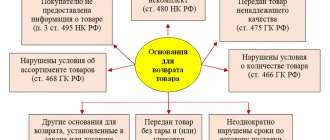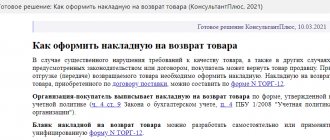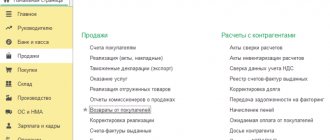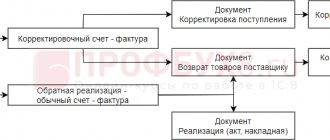Photo from the site moscow-city.online The agreement between the seller (supplier) and the buyer very often does not clearly state the conditions under which the goods are returned - for example, if they were not sold. As a result, the so-called “reverse implementation”, and both parties will overpay taxes. Elena Sapego, head of tax practice, partner at the Stepanovsky, Papakul and Partners Law Office, and assistant lawyer Alexey Korol, tell us how to avoid the problem.
— Adapting to the current state of the market, suppliers and buyers often write the well-known phrase in contracts as a carbon copy: “Delivery is carried out on deferred payment terms until the goods are sold to end consumers, with the buyer having the right to return the delivered goods, if within the period established by the contract , the goods were not sold."
Elena Sapego Head of Tax Practice, Partner at the Law Office "Stepanovsky, Papakul and Partners" Alexey Korol Assistant Attorney at the Law Office "Stepanovsky, Papakul and Partners"
Yes, such a procedure for the relationship between the parties and the direct return of goods is possible - from the point of view of civil law. However, by including such a condition for the return of goods in the contract, companies do not take into account the possible tax consequences. And they forget to include in the contract rules that will ensure optimization of the relationship from the point of view of paying taxes.
Return of goods after acceptance by the buyer for accounting
According to the position of the official authorities, if on the date of return the goods are registered, the return of the goods by the buyer is recognized as a reverse sale.
It does not matter for what reasons the goods are returned. In this case, the buyer, if he is a VAT payer, must issue an invoice to the seller (letters from the Ministry of Finance of the Russian Federation dated November 29, 2013 No. 03-07-11/51923, dated August 10, 2012 No. 03-07-11/280).
Example Promooborudovanie LLC purchases blanks for the production of parts from Omega LLC.
Products are purchased in batches of 1000 pieces. On a monthly basis, upon acceptance of MPZ, incoming quality control is carried out in order to identify defective workpieces. On April 30, 2021, the next batch of workpieces arrived, which were entered into the warehouse, and the arrival of the goods and materials was reflected in the accounting.
Before sending the workpieces to the workshop, the quality control inspector, conducting laboratory incoming quality control, discovered metal defects that were not visible during the initial visual inspection and were revealed only during ultrasonic testing. According to the terms of the contract, if a defect is detected in the control samples, the entire batch must be returned.
In this case, Promooborudovanie LLC, the buyer, issues an invoice for the returned shipment and charges VAT on the proceeds from the reverse sale.
The invoice for reverse sales of Promooborudovanie LLC (former buyer) is registered in the sales book, and the invoice received from Omega LLC is registered in the purchase book.
LLC "Omega" (former seller) registers the initial invoice in the sales book, and the one received from LLC "Promooborudovanie" - in the purchase book (clause 5 of article 171, clause 10 of article 172 of the Tax Code, letters of the Ministry of Finance dated November 29, 2013 No. 03-07-11/51923, 08/28/2012 No. 03-07-09/126).
If the buyer and seller are on OSNO, then in the seller’s purchase book and the buyer’s sales book, an invoice for the return of goods is registered using the transaction code “01” (letter of the Federal Tax Service of the Russian Federation dated September 20, 2016 No. SD-4-3 / [email protected] ).
Returning goods before the buyer accepts them for accounting
As stated above, the issuance of an invoice for the return of goods depends on whether the returned goods are registered or not.
If the goods are accepted, you need to issue a regular invoice for return sales. In this case, the seller and buyer change places, and the goods are returned to the starting point.
If the buyer returns an item that was not accepted for registration, or only part of the item, the seller needs to issue an adjustment invoice.
Example
During the acceptance of workpieces received from Omega LLC, OO Promoborudovanie identified defects that arose during their improper transportation (chips, cracks, etc.). It was decided to return the entire batch of blanks. Since the buyer did not accept the goods for registration, the transfer of ownership of the blanks to Promooborudovanie LLC did not occur, so there is no reverse sale in this case and there is no need to issue an invoice to Omega LLC (Clause 1, Article 39 of the Tax Code RF, letter of the Ministry of Finance of Russia dated 04/07/2015 No. 03-07-09/19392).
The defective batch of blanks was sent to the supplier with a TORG-12 invoice marked “Return”. The remaining documents confirming the fact of the return of the blanks (return certificate, claim, agreement to terminate the contract, etc.) were sent later.
For Promooborudovanie LLC, the return of workpieces without registering them did not entail any tax consequences; nothing needs to be reflected in the purchase book and sales book .
And Omega LLC, as the seller who reflected the sales in the sales book, must draw up an adjustment invoice and register it in the purchase book (letters of the Ministry of Finance dated 08/10/2012 No. 03-07-11/280 and 08/07/2012 No. 03-07 -09/109, Federal Tax Service dated 07/05/2012 No. AS-4-3/ [email protected] ).
Basic rights of buyers
Consumer rights when returning and exchanging depend on what product was purchased: high-quality or low-quality. In the first case, the buyer must apply Art. 25 of the Law of the Russian Federation “On the Protection of Consumer Rights”. In the second - Art. 18 of the specified document and paragraph 27 of Government Decree No. 55 of January 19, 1998.
The buyer of a high-quality non-food product (in particular, shoes, clothing) can exchange it in the store within 14 days. At the same time, the item must retain its consumer properties and presentation. For example, a woman can exchange shoes of size 38 for an identical model of size 39 or with a different color.
Some quality products cannot be returned to the retail outlet or exchanged. These include, but are not limited to, medicines, cosmetics, underwear, books, jewelry, animals and plants.
If deficiencies are identified, the consumer has a wider range of rights. He may require the trade organization to take the following actions:
- replace the defective product with a similar one of the same or a different brand (including recalculating the cost);
- to reduce the price;
- fix faults free of charge or pay repair costs;
- take the item back and return the money.
A penalty (penalty, fine) is collected from the seller if provided for in the contract. However, the client in any case can demand compensation for losses incurred due to the acquisition of a bad item.
Partial return of goods before the buyer accepts it for accounting
Let's consider a situation where the buyer, upon acceptance of the goods, identifies a discrepancy with the specifications, but only part of the received goods is subject to return (not acceptance).
In this case, the buyer (letter of the Ministry of Finance dated May 12, 2012 No. 03-07-09/48):
- Registers in the purchase book the initial “shipping” invoice only for the cost of those goods that were accepted for accounting;
- The CSF received from the seller is not recorded either in the purchase book or in the sales book.
The seller registers his copy of the adjustment invoice in the purchase book and adjusts the VAT payable to the budget by the amount of tax on the value of the returned blanks accepted for deduction.
Preparation of invoices when returning goods due to mis-grading
Sometimes in practice there are situations when the supplier transfers goods to the buyer, making mistakes in the assortment.
According to the Ministry of Finance of the Russian Federation, in such a situation one should proceed as follows. If the buyer identified and accepted a re-grading, when in fact there were more of some goods and less of others, it is necessary to issue an adjustment invoice. In this case, the supplier has two options for issuing an adjustment invoice to one initial one (letter of the Ministry of Finance of Russia dated November 17, 2016 No. 03-07-09/67407):
- issue one adjustment invoice, increasing the quantity of some goods and decreasing the quantity of others;
- issue two adjustment invoices. In the first, increase the number of goods that were shipped more than required. In the second, reduce the quantity of those goods that the supplier brought less.
The agency explains its conclusion by saying that the rules for drawing up adjustment invoices do not contain any specifics for filling out documents for such a case.
This means that the proposed options do not contradict the law. Please note that, in our opinion, this approach is correct in the case where both names of goods were indicated on the original invoice. If the buyer, having identified the misgrading, finds goods that are not indicated in the original invoice, then the adjustment procedure will be different: the supplier in this case does not issue an adjustment invoice, but makes corrections to the original invoice.
In our opinion, this approach is correct in the case where both names of goods were indicated on the original invoice. If the buyer, having identified misgrading, finds goods that are not indicated in the original invoice, then the adjustment procedure will be different. The supplier does not issue a correction invoice, but makes corrections to the original invoice.
Return of goods by a VAT non-payer
If the seller and buyer use special modes (STS, UTII, etc.), invoices for sales and returns are not issued, and entries in the purchase and sales book are not made.
If the seller is located on OSNO, and the goods were sold to a company that is not a VAT payer, then when the buyer returns goods (both accepted and not accepted by him for registration), the supplier must issue an adjustment invoice for the cost of the goods returned by the buyer and register it in shopping book.
When the supplier registers an adjustment invoice drawn up when returning goods from a buyer who does not pay VAT (except for individuals), column 2 of the supplier’s purchase book reflects transaction code 16.
Thus, the seller registers the same invoice twice: the first time - in the sales book with code KVO 01 or 26, the second time - in the purchase book with code KVO 16.
Accounting Rules
Accounting for returns of defective products depends on the specific situation.
Before acceptance
Before accepting the goods, the following records are made::
After acceptance
The claim to the supplier is made by posting D76/2 - K60.
To recover the VAT amount, records are required:
- D19 – K68.
- D76/2 – K19.
Receipt of funds from the seller: D51 – K76/2.
From an individual
If the buyer of a low-quality product was an individual, then postings will be made through the following encodings:
- D76 – K90/1 reversal of sales proceeds.
- D90/2 – K41 reversal of the purchase price.
- D76 – K50 refund.
Return of goods by an individual
When selling goods, works or services to individuals for cash, the VAT payer supplier has the right not to issue invoices to them.
This is stated in paragraph 7 of Article 168 of the Tax Code of the Russian Federation. In this case, you can register a cash register tape in the sales book. If individuals pay in non-cash form, the VAT payer seller must issue a consolidated invoice for all sales and register it in the sales book (letter of the Ministry of Finance of the Russian Federation dated June 15, 2015 No. 03-07-14/34405. The seller should do the same in a situation where individuals receive goods by mail (letter of the Ministry of Finance of Russia dated 06/20/14 No. 03-07-09/29630), and when goods are transferred free of charge to employees (letter of the Ministry of Finance of Russia dated 02/08/2016 No. 03-07-09/6171 ).
Consolidated invoices and cash register tapes are registered in the sales book of the seller with code KVO 26.
If the buyer, an individual, returned the goods or refused the work (service), the seller must return the money to him. The salesperson should then record in the purchase ledger the consolidated invoice or cash register tape that was previously recorded in the sales ledger.
In this case, in the column intended for the KVO code, you should put 17 (order of the Federal Tax Service of Russia dated March 14, 2016 No. ММВ-7-3 / [email protected] , letter of the Ministry of Finance of the Russian Federation dated July 30, 2014 No. 03-07-09/37589). In the column intended for information about the document confirming the payment of tax, you must indicate the number and date of the document drawn up when returning money to the buyer.
According to officials (letter of the Ministry of Finance dated March 19, 2013 No. 03-07-15/8473) and tax authorities (letter of the Federal Tax Service dated May 14, 2013 No. ED-4-3 / [email protected] ), if a buyer who did not pay VAT when selling goods was a cash receipt has been issued without issuing an invoice (in retail trade using cash register), in the seller's purchase book you can register the details of the cash receipt issued when returning money to the buyer (if there are documents confirming the receipt of returned goods).
What to do when the store does not intend to return the money
A store's refusal can be direct or disguised. In the first case, employees give an oral or written response indicating the reasons for disagreement. Disguised refusal is often expressed in the following actions:
- default;
- promises to fulfill demands in the future;
- repairs carried out without the buyer’s consent.
In all the situations described, you need to address the seller with a pre-trial claim (hand it to the employee against signature or send a registered letter). The document should describe the circumstances of the dispute and formulate the demand. If the counterparty again disagrees or does not respond to the claim within 30 days, it is necessary to go to court.
Filing a claim for the return of defective goods is subject to the following rules:
- The top “header” contains information about the plaintiff: full name, residential address, mobile phone. Just below are the details of the seller (manufacturer): name, legal address, telephone, e-mail.
- The title of the document is in the center.
- The first paragraphs describe in detail information about the purchased product: number, article, appearance, distinctive features, warranty period. Next, the circumstances of the acquisition of the item are indicated: date, time and place of purchase.
- The reasoning part reflects the facts of detection of malfunctions, return of goods to the seller, and receipt of refusal to satisfy monetary claims. The plaintiff's arguments are supported by references to evidence: photographs, opinions of commodity experts, inspection and acceptance certificates, checks, letters and other documents.
- The last paragraph states the request for a refund indicating the amount. At the end of the document, the date of preparation, the surname and initials of the plaintiff, and signature are indicated.
You can claim for the return of defective goods using the link.
Gathering evidence and filing a claim is difficult work. It requires not only perfect knowledge of legal acts on the protection of consumer rights, but also taking into account all the nuances of the situation (categories of shortcomings, reasons for their occurrence, the seller’s reaction). Timely contacting a professional increases the buyer’s chances of winning in court. After all, thanks to his wealth of experience, the lawyer knows what tricks unscrupulous sellers resort to in order to evade responsibility.
Return of goods in VAT returns
When the buyer returns the goods to him, the seller accepts for deduction the VAT accrued upon their shipment. In the VAT return for the quarter in which the returned goods were received from the buyer, the seller reflects:
- in Sect. 8 - information about the invoice registered in the purchase book when returning goods by the buyer (clause 45 of the Procedure for filling out the declaration). Read about which invoice is registered in the purchase book when returning a quality product here, and here for a low-quality product;
- in line 120 section. 3 - the amount of VAT accepted for deduction on returned goods (clause 38.8 of the Procedure for filling out the declaration).
When returning goods for which VAT has been deducted, the buyer must issue an invoice to the seller for their value. In the VAT return for the quarter in which the goods were returned to the seller, the buyer reflects (clause 38.1 of the Procedure for filling out the declaration):
- in Sect. 9 - information about this invoice registered in the sales book (clause 47 of the Procedure for filling out the declaration);
- in columns 3 and 5 on line 010 section. 3 - the cost of goods on this invoice, taxed at a rate of 18%, and the amount of VAT accrued on them;
- in columns 3 and 5 on line 020 section. 3 - the cost of goods on this invoice, taxed at a rate of 10%, and the amount of VAT accrued on them.
Please note that if the buyer does not accept the returned goods for accounting and, accordingly, the VAT on them is deducted, the return of goods does not need to be reflected in the VAT return.
Based on materials from the magazine “Our Accounting”
Reflection of returns in the seller's accounting
Like any other fact of the economic life of an organization, returns must also be reflected in accounting. Moreover, entries made earlier will have to be reversed. The reversal will have to be made according to the following postings.
| Operation | Contents of operation |
| D62 K90/Revenue | The amount of revenue is reversed by the cost of goods that were returned |
| D90/Cost price K41 | A reversal of the cost that was written off for returned goods is carried out. |
| D90/VAT K68/VAT calculations | VAT is deductible from the cost of goods that were returned. |






